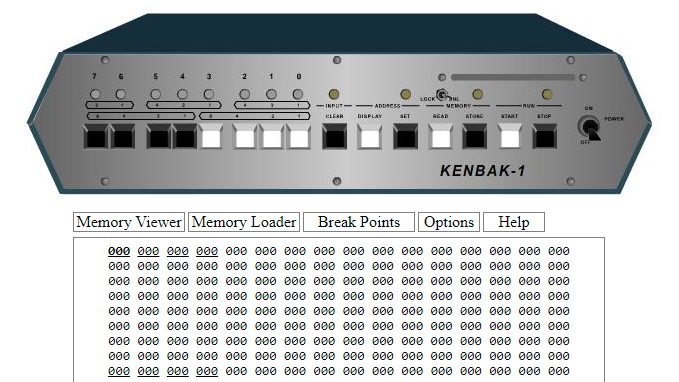Ever heard of the KENBAK-1? Recognized as the first personal computer, created by John Blankenbaker and sold in 1971 in comparatively small numbers, it’s now a piece of history. But don’t let that stop you if you are curious, because of course there is an emulator on the web.
If the machine looks a bit strange, that’s because early computers of this type did not have the kind of controls (or displays) most people would recognize today. Inputs were buttons and switches, and outputs were lights showing binary values of register contents. The machine could store and run programs, and those programs were entered in pure machine code (no compiler, in other words) by setting individual bit values via the switches. In fact, the KENBAK-1’s invention preceded that of the microprocessor.
The KENBAK was the first electronic, commercially available computer that was not a kit and available to the general population, but the story of how it came to be is interesting. Back in 2016 we covered how that story was shared by John Blankenbaker himself at Vintage Computer Festival East.
















I’m pretty sure the first “PC” article I recall seeing was in a Popular Electronics in 1969 that used a phone pulse dialer as input, but then that was a long time ago and I didn’t bother to commit that article to memory. It was probably more like a calculator, but then the first “computers” WERE calculators.
The first crossbar exchange with a SLM Subscribers Line Marker and a REG Register was technically a computer.
And 5 years later i did findout how a phone dialer swiths worked ;)
My first contact, with a micro processor in late 1980, was “how the hell” can you do that much different things with so less pins on this “magic” IC. The 8086 had (only) 64 pins IIRC and i was used to build a (sort of) 7474 flip-flop in a matchbox to figureout how it did work.
By revers engineering the eproms (2k x 16) learned the machine code to read en write (in Hex). Afterwards have seen “strange looks on peoples faces” when i fixed some bugs in binairy libarary files, in front of them.
A small change in tp521.lib, only 1 byte from 0A to 2A, did solve the runtime error 200 with BP 7 (Borland Pascal).
Runtime error 200 is a divide by zero what was also called as you have a computer running on more than 200 Mhz
and that patch will shift that problem into the 200 Phz (Peta, 10^12) range.
The fist commercially availabe perconal computer was the Olivetti Programma 101 that looked a lot like a calculator, actually with the printing mechanism and the keyboard derived from electromechanical calulators of the era except it was electronic, programmable and cabable of load an dave the programs on magnetic cards
HaD has covered Olivetti a couple of times…
https://hackaday.com/2020/10/02/retrotechtacular-the-5000-40-pound-hp-classroom-computer/
https://hackaday.com/2015/12/08/retrotechtacular-a-desktop-computer-from-1965/
I remember a “computer” with a phone dial, but it was earlier, maybe around 1963. And I’m thinking Electronics Illustrated.
EDSAC? It had a rotary dial, too. The OXO game used it.
https://en.wikipedia.org/wiki/OXO_(video_game)
There’s also an emulator for 16-Bit Windows and Motorola 68000 Macintoshs.
The January 1960 issue of Electronics has a “computer” project with phone dial.
But so does the Nov 1966 issue. These are more like calculators, but they were there. Part of that wave of computer builders that existed before microprocessors.
Michael, you’re 100% right about it being Electronics Illustrated, but not the year — it was 1966. I found the exact issue that popped up in my head (see link below). That was actually before I switched my major from chemistry to engineering (I graduated HS in 1969) — I really hated the rote memorization of the 2,400 page organic chemistry text book! Here’s a link to that Nov 66 EI issue: https://worldradiohistory.com/Archive-Electronics-Illustrated/Electronics-Illustrated-1966-11.pdf Seems that it’s barely a calculator. I love that just about everything is archived on the internet !!!
“Last modified: August 2009”
Well, that was about time.
If you would like to make your own KENBAK-1 reproduction or just run an emulator that has a built in IDE with an Assembler and Debugger check out my https://hackaday.io/project/178787-25-scale-kenbak-1-personal-computer-reproduction project.
Has Benchoff been stuffed that far down the HaD memory hole?
KENBAK seen previously in these pages:
https://hackaday.com/2011/09/30/recreating-the-first-pc/
https://hackaday.com/2016/05/23/the-man-who-didnt-invent-the-personal-computer/
And of course the most recent by Gardi, just mentioned above.
“Ever heard of the KENBAK-1? Recognized as the first personal computer [..]”
So the Kenbak-1 was as much a PC as the Trabi was a car? 😂
This comes up often.
Define Personal Computer
Define Trabi
Define Car
The main limitation of the Kenbak-1 was just 256 bytes of memory, and shift register based too, so it wasn’t true RAM.
At the same time,1970/71, Joe Weisbecker, an engineer at RCA, was working alone in his basement, on a TTL prototype of the architecture that would become the RCA CDP1802.
Using about 100 TTL ICs, Weisbecker’s prototype used the latest semiconductor RAM, extendable to a full 64K bytes – if you had deep enough pockets.
If you like TTL computers, the full manual and hand drawn schematics for Weisbecker’s prototype is here:
http://www.cosmacelf.com/publications/books/system-00-manual-orig.pdf
He hand an article in Byte about his CHIP-8 language, a low level high level language(or was it the reverse?). I had the impression he wrote it before the 1802, so maybe it was for this homemade computer